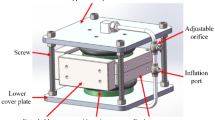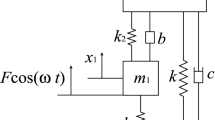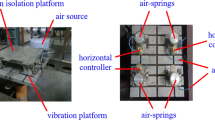Abstract
Background
Nowadays, vibration control is one of the limitless and major operating parameters in science and technology. The most promising and adaptive dynamic vibration absorber (DVA) with an air spring–air damper assembly is designed with a facility to change the spring rate and damping in the system to control the vibration.
Method
To optimize and effectively controlling the resonant amplitude ratio efficiently, a Maxwell-type air damper mathematical model is formulated for an SDOF vibrating system subjected to sinusoidal base excitation for better performance of DVA. Insight into the physics of such systems was carried out by mathematical modeling, design, and development of an air spring–air damper system for the SDOF vibrating system.
Result
Experimental investigation of an air spring–air damper for the primary mass displacement amplitude to optimize and effectively control the vibration. It will provide a compact and right platform for DVA among the current potential market and provide the major attention of the control community as a platform for the development of low-frequency nonlinear devices.









Similar content being viewed by others
References
Asami T, Nishihara O (1999) Analytical and experimental evaluation of an air damped dynamic vibration absorber: design optimizations of the three-element type model. Journal of Vib Acoust 121(3):334–342
Deo H, Suh NP (2006) Pneumatic suspension system with independent control of damping, stiffness and ride-height. Design (Theorem 2): 2–7
Heertjes M, van de Wouw N (2006) Nonlinear dynamics and control of a pneumatic vibration isolator. J Vib Acoust 128(4):439
Todkar RG, Joshi SG (2011) The effect of mass ratio and air damper characteristics on the resonant response of an air damped dynamic vibration absorber. Modern Mech Eng 01(02):93–103
Nelson PG (2002) Supporting active electro-pneumatic vibration isolation systems on platforms supported by STACIS hard-mount piezoelectric isolation systems. Tech Manuf Corp (5)
Mizuno T, Toumiya T, Takasaki M (2003) Vibration isolation system using negative stiffness. JSME Int J Ser C 46(3):807–812
Lazarian AV (2009) Mathematical model of pneumatic systems for shock. International Scientific Conference Transbaltica, pp 141–146
Zhong Y, Yang Q, Bao G (2008) Nonlinearity analyses of pneumatic vibration isolation system with simple harmonic excitations. J Anesth Analg 107(3):1040
Turnip A, Hong KS, Park S (2009) Modeling of a hydraulic engine mount for active pneumatic engine vibration control using the extended Kalman filter. J Mech Sci Technol 23(1):229–236
Moheyeldein MM et al (2018) An analytical study of the performance indices of air spring suspensions over the passive suspension an analytical study of the performance indices of air spring suspensions over the passive suspension. Beni-Suef Univ Journal Basic App Sci
Fongue WA, Pelz P, Kieserling J (2012) The dynamic performance of air spring air damping systems by means of small excitations. Proc Int Conf Noise Vib Eng ISMA 2012:3901–3912
Kumar RBDPVA (2014) Design and optimization of hydro-pneumatic suspension system through. IJETT 16(6):268–275
Luo T et al (2015) A improved hydro-pneumatic suspension: mathematical modeling and simulation. IJRMET 5(5762):37–42
Rajeswari KL (2013) Real time vibration control of active suspension system with active force control using iterative learning algorithm. Int J Adv Comput Res 3(12):2–7
Huang T et al (2018) Research on vehicle height adjustment control of electronically controlled air suspension. SAE Technical Paper (2)
Qi H et al (2019) Improvement of both handling stability and ride comfort of a vehicle via coupled hydraulically interconnected suspension and electronic controlled air spring. Proc IMechE Part D J Autom Eng 193:1–20
Zargar B, Fahim A, Jnifene A (2011) Development, validation, and parameter sensitivity analyses of a nonlinear mathematical model of air springs. J Vib Control 18(12):1777–1787
Warczek J, Burdzik R, Perun G (2014) The method for identification of damping coefficient of the trucks suspension. Trans Tech Publ 588:281–289
Mazzola L, Berg M (2014) Secondary suspension of railway vehicles—air spring modelling: performance and critical issues. Proc Inst Mech Eng Part F: J Rail Rapid Transit 228(3):225–241
Zhu H et al (2017) Nonlinear dynamic model of air spring with a damper for vehicle ride comfort. Nonlinear Dyn 89:1545–1568
Sharma SK, Saini U, Kumar A (2019) Semi-active control to reduce lateral vibration of passenger rail vehicle using disturbance rejection and continuous state damper controllers. J Vib Eng Technol 7:117–129
Gmbh AV (2007) Air suspension and air damping in the context of comfort. Dyn Authors 109:7–10
Balaji PS, Selvakumar K (2020) Applications of nonlinearity in passive vibration control: a review. J Vib Eng Technol. https://doi.org/10.1007/s42417-020-00216-3
Author information
Authors and Affiliations
Corresponding author
Additional information
Publisher's Note
Springer Nature remains neutral with regard to jurisdictional claims in published maps and institutional affiliations.
Rights and permissions
About this article
Cite this article
Kumbhar, M.B., Salunkhe, V.G., Borgaonkar, A.V. et al. Mathematical Modeling and Experimental Evaluation of an Air Spring–Air Damper Dynamic Vibration Absorber. J. Vib. Eng. Technol. 9, 781–789 (2021). https://doi.org/10.1007/s42417-020-00263-w
Received:
Revised:
Accepted:
Published:
Issue Date:
DOI: https://doi.org/10.1007/s42417-020-00263-w




